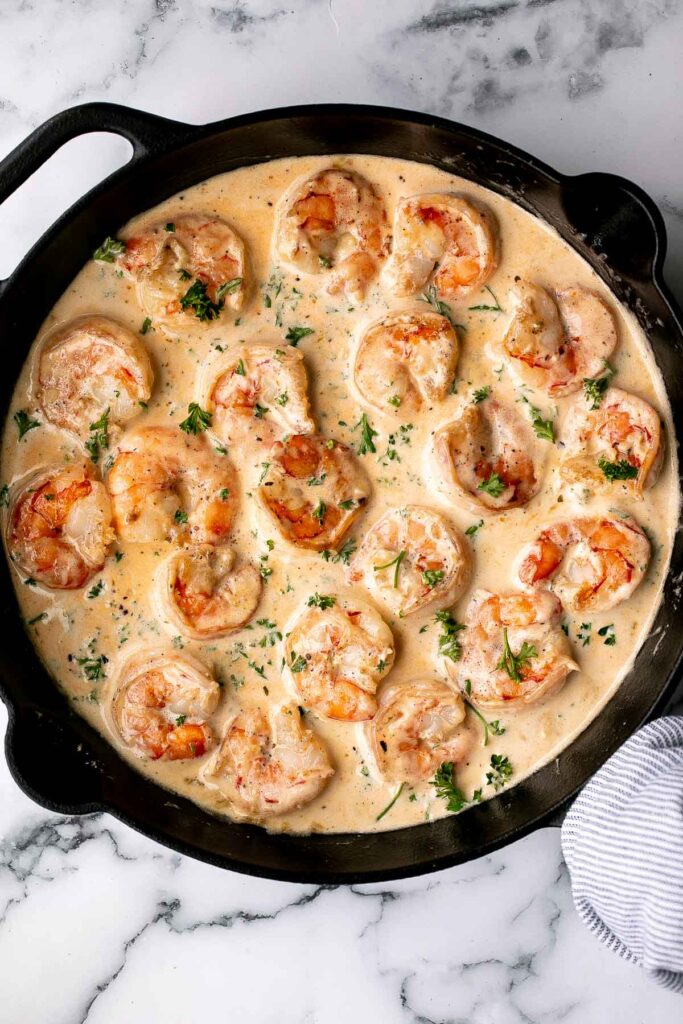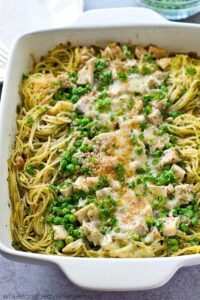In the world of comfort food that manages to feel both indulgent and sophisticated, few dishes can match the timeless appeal of Creamy Garlic Shrimp. This extraordinary recipe represents the perfect marriage of succulent seafood and rich, aromatic flavors, creating a dish that satisfies on multiple levels while remaining surprisingly accessible to home cooks of all skill levels. The combination of plump, tender shrimp bathed in a luxurious cream sauce infused with fragrant garlic creates an experience that is both comforting and elegant, making it equally suitable for intimate family dinners and special occasion entertaining.
The beauty of Creamy Garlic Shrimp lies in its remarkable ability to transform simple, high-quality ingredients into something truly spectacular. Fresh shrimp, when properly prepared and cooked, provides a sweet, delicate flavor and firm texture that serves as the perfect canvas for the rich, aromatic sauce. The garlic component adds depth and complexity without overwhelming the natural sweetness of the seafood, while the cream creates a luxurious mouthfeel that brings all the elements together in perfect harmony.
This comprehensive guide will take you through every aspect of creating perfect Creamy Garlic Shrimp, from selecting the finest shrimp and understanding the nuances of garlic preparation to mastering the techniques that ensure a flawlessly executed cream sauce every time. Whether you’re a seafood enthusiast looking to expand your repertoire or a comfort food lover seeking a dish that delivers both satisfaction and sophistication, this recipe will become a treasured addition to your culinary collection.
The Art of Shrimp Selection and Preparation
The foundation of exceptional Creamy Garlic Shrimp begins with selecting the highest quality shrimp available and preparing them properly to ensure optimal flavor, texture, and visual appeal. Understanding the different types of shrimp, their characteristics, and the proper preparation techniques is essential for achieving restaurant-quality results in your home kitchen.
When selecting shrimp for this dish, size matters significantly in terms of both presentation and cooking time. Large or extra-large shrimp (16-20 count per pound or 21-25 count per pound) are ideal for Creamy Garlic Shrimp because they provide substantial, satisfying bites that won’t be overwhelmed by the rich sauce. These larger shrimp also have a more pronounced flavor and a firmer texture that holds up well to the cooking process without becoming rubbery or overcooked.
Fresh shrimp should have a mild, ocean-like scent without any strong fishy odors, which can indicate that the shrimp is past its prime. The shells should be firm and translucent, with no black spots or discoloration. If fresh shrimp is not available, high-quality frozen shrimp can be an excellent alternative, often providing better flavor and texture than fresh shrimp that has been sitting for several days. When purchasing frozen shrimp, look for individually quick-frozen (IQF) shrimp that have been frozen without added water or preservatives.
The preparation process begins with proper thawing if using frozen shrimp. The best method is to place the shrimp in a colander and rinse them under cold running water for several minutes, gently separating any pieces that may be stuck together. This method thaws the shrimp quickly while maintaining their texture and preventing the growth of harmful bacteria that can occur with slow thawing methods.

Peeling and deveining shrimp is a crucial step that affects both the appearance and eating experience of the final dish. While some cooks prefer to leave the tails on for presentation purposes, removing them entirely makes the dish more enjoyable to eat, especially when served over pasta or rice. The deveining process involves making a shallow cut along the back of the shrimp and removing the dark vein, which is actually the digestive tract. While this vein is not harmful, removing it improves both the appearance and texture of the finished dish.
Proper seasoning of the shrimp before cooking is essential for building layers of flavor throughout the dish. A light coating of salt and freshly ground black pepper should be applied to the shrimp at least 10-15 minutes before cooking, allowing the seasoning to penetrate the flesh and enhance the natural sweetness of the seafood. Some cooks prefer to add a touch of paprika or garlic powder at this stage, though the primary flavoring will come from the cooking process and sauce.
Understanding Garlic: The Heart of the Dish
Garlic serves as the aromatic foundation of Creamy Garlic Shrimp, providing the complex, savory notes that define the character of this beloved dish. Understanding how to select, prepare, and cook garlic properly is crucial for achieving the perfect balance of flavors that makes this recipe so appealing to garlic lovers while remaining approachable for those with more moderate tastes.
The selection of garlic can significantly impact the final flavor of the dish. Fresh garlic bulbs should be firm and heavy for their size, with tight, papery skin and no soft spots or green shoots emerging from the cloves. Avoid garlic that feels light or hollow, as this indicates that the cloves have dried out and lost much of their flavor and moisture. The individual cloves should be plump and firm when pressed gently, and they should separate easily from the bulb when needed.
The preparation of garlic for Creamy Garlic Shrimp requires careful attention to technique and timing. Garlic should be minced finely to ensure even distribution throughout the sauce and to prevent any single bite from being overwhelmed by large pieces of garlic. The mincing should be done just before cooking to preserve the volatile compounds that give garlic its characteristic flavor and aroma. Pre-minced garlic from jars, while convenient, cannot provide the same intensity and freshness that this dish requires.
The cooking of garlic is perhaps the most critical aspect of the entire recipe, as improperly cooked garlic can ruin an otherwise perfect dish. Garlic should be cooked gently over medium heat, stirring constantly, until it becomes fragrant and just begins to turn golden. This process typically takes 30-60 seconds, depending on the heat level and the amount of garlic being used. The goal is to release the aromatic compounds without allowing the garlic to brown or burn, which would introduce bitter flavors that can overpower the delicate sweetness of the shrimp.
The timing of garlic addition is crucial for achieving the perfect flavor balance. In most preparations, the garlic is added to the pan after the shrimp have been partially cooked and removed, allowing the garlic to cook in the flavorful fond left behind by the shrimp. This technique ensures that the garlic absorbs the seafood flavors while contributing its own aromatic qualities to the developing sauce.
Different varieties of garlic can provide subtle variations in flavor profile. Hardneck garlic varieties tend to have a more complex, robust flavor with subtle spicy notes, while softneck varieties are generally milder and sweeter. For Creamy Garlic Shrimp, either type can work well, though many cooks prefer the more pronounced flavor of hardneck varieties when they want the garlic to be a prominent feature of the dish.
Mastering the Cream Sauce Technique
The cream sauce is the luxurious element that transforms simple sautéed shrimp and garlic into the indulgent comfort food that defines Creamy Garlic Shrimp. Understanding the principles behind cream sauce preparation, the role of each ingredient, and the techniques that ensure a smooth, stable, and flavorful result is essential for achieving restaurant-quality results at home.
Heavy cream serves as the foundation of the sauce, providing richness, body, and a luxurious mouthfeel that coats the shrimp beautifully. The fat content in heavy cream (typically 36-40%) is crucial for creating a stable emulsion that won’t break or curdle when heated. Lower-fat alternatives such as half-and-half or milk can be used, but they require more careful temperature control and may not achieve the same rich consistency that makes this dish so appealing.
The technique for incorporating cream into the sauce requires careful attention to temperature and timing. The cream should be added gradually to the hot pan, stirring constantly to prevent it from curdling or separating. The heat should be reduced to medium-low once the cream is added, as high heat can cause the proteins in the cream to coagulate and create an unpleasant, grainy texture. The sauce should be brought to a gentle simmer, not a rolling boil, and maintained at this temperature while it reduces and thickens.
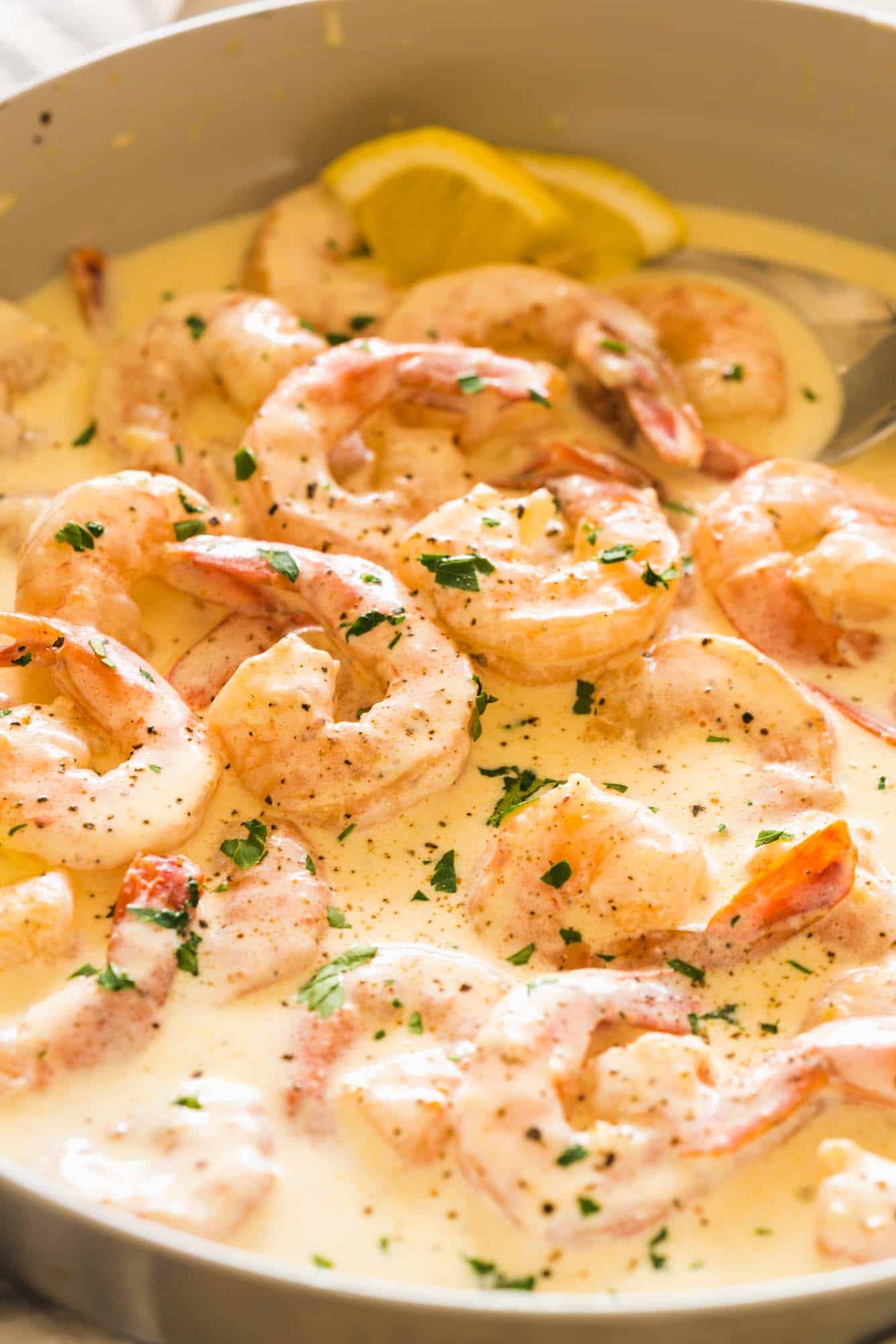
The reduction process is crucial for achieving the proper consistency and concentration of flavors in the cream sauce. As the sauce simmers gently, the water content evaporates, leaving behind a more concentrated mixture of cream, garlic, and the flavorful compounds from the shrimp. This process typically takes 3-5 minutes, depending on the amount of sauce and the heat level. The sauce is ready when it coats the back of a spoon and has a consistency similar to heavy cream.
Seasoning the cream sauce requires a delicate balance to enhance the natural flavors without overwhelming them. Salt is essential for bringing out the sweetness of the shrimp and the aromatic qualities of the garlic, but it should be added gradually and tasted frequently, as the sauce will concentrate as it reduces. Freshly ground white pepper is often preferred over black pepper for cream sauces, as it provides heat without the visual specks that can detract from the sauce’s appearance.
The addition of acid can help balance the richness of the cream and brighten the overall flavor profile of the dish. A small amount of fresh lemon juice, white wine, or even a splash of white wine vinegar can provide this balance without overwhelming the other flavors. The acid should be added near the end of the cooking process to preserve its bright, fresh character.
Herbs can provide a fresh, aromatic finish that complements the rich cream sauce beautifully. Fresh parsley is traditional and provides a bright, clean flavor that cuts through the richness, while fresh thyme or chives can add more complex herbal notes. Dried herbs can be substituted but should be added earlier in the cooking process to allow their flavors to develop and meld with the other ingredients.
Cooking Techniques for Perfect Shrimp
Achieving perfectly cooked shrimp in Creamy Garlic Shrimp requires understanding the unique characteristics of seafood cookery and applying techniques that ensure the shrimp remain tender, juicy, and flavorful while developing the proper texture and appearance that makes the dish visually appealing.
The cooking process begins with ensuring that the shrimp are at the proper temperature before they hit the pan. Shrimp that are too cold will lower the temperature of the cooking surface, leading to uneven cooking and potentially tough, rubbery results. The shrimp should be removed from refrigeration 10-15 minutes before cooking to allow them to come closer to room temperature, which promotes more even cooking throughout.
The choice of cooking fat can significantly impact both the flavor and the cooking characteristics of the shrimp. Butter provides rich flavor and helps with browning, but it has a relatively low smoke point and can burn easily if the heat is too high. Olive oil has a higher smoke point and provides a more neutral flavor that allows the natural sweetness of the shrimp to shine through. Many cooks prefer to use a combination of butter and oil, which provides the flavor benefits of butter with the higher smoke point of oil.
The cooking surface should be properly preheated before adding the shrimp. A hot pan is essential for achieving the light caramelization that adds depth of flavor and visual appeal to the shrimp. However, the heat should not be so high that the shrimp cook too quickly on the outside while remaining undercooked on the inside. Medium-high heat is typically ideal for most stovetop cooking.
The shrimp should be arranged in a single layer in the pan without overcrowding, which can cause them to steam rather than sear properly. If necessary, cook the shrimp in batches to ensure that each piece has adequate contact with the cooking surface. Overcrowding also makes it difficult to monitor the cooking progress and can lead to uneven results.
The timing of shrimp cookery is crucial, as shrimp can go from perfectly cooked to overcooked in a matter of seconds. Most shrimp will cook in 2-3 minutes per side, depending on their size and the heat level. The shrimp are done when they turn pink and opaque throughout, with no translucent areas remaining. Overcooked shrimp become tough and rubbery, while undercooked shrimp can be unpleasant to eat and potentially unsafe.
The visual cues for properly cooked shrimp are important to recognize. Raw shrimp are translucent and grayish in color, while cooked shrimp turn pink and opaque. The shrimp should curl slightly as they cook, forming a loose C-shape. If the shrimp curl tightly into an O-shape, they are likely overcooked. The flesh should feel firm but not hard when gently pressed with a spatula or tongs.
Flavor Development and Seasoning Balance
Creating the perfect flavor profile for Creamy Garlic Shrimp requires understanding how different ingredients interact and complement each other, as well as knowing how to adjust seasoning throughout the cooking process to achieve the ideal balance of richness, brightness, and savory depth that makes this dish so satisfying.
The foundation of flavor development begins with the fond created by cooking the shrimp. This fond contains concentrated flavors from the Maillard reaction, the chemical process that occurs when proteins are exposed to high heat. These caramelized bits are pure flavor gold and should be incorporated into the sauce through proper deglazing techniques. A splash of white wine, chicken broth, or even water can be used to deglaze the pan, scraping up the browned bits and incorporating them into the developing sauce.
The garlic component provides the primary aromatic foundation of the dish, but its flavor can be enhanced and complemented through careful technique and timing. Cooking the garlic gently until fragrant releases its volatile compounds without creating the bitter notes that can result from overcooking. The amount of garlic can be adjusted based on personal preference, but it should be balanced so that it enhances rather than overwhelms the delicate flavor of the shrimp.
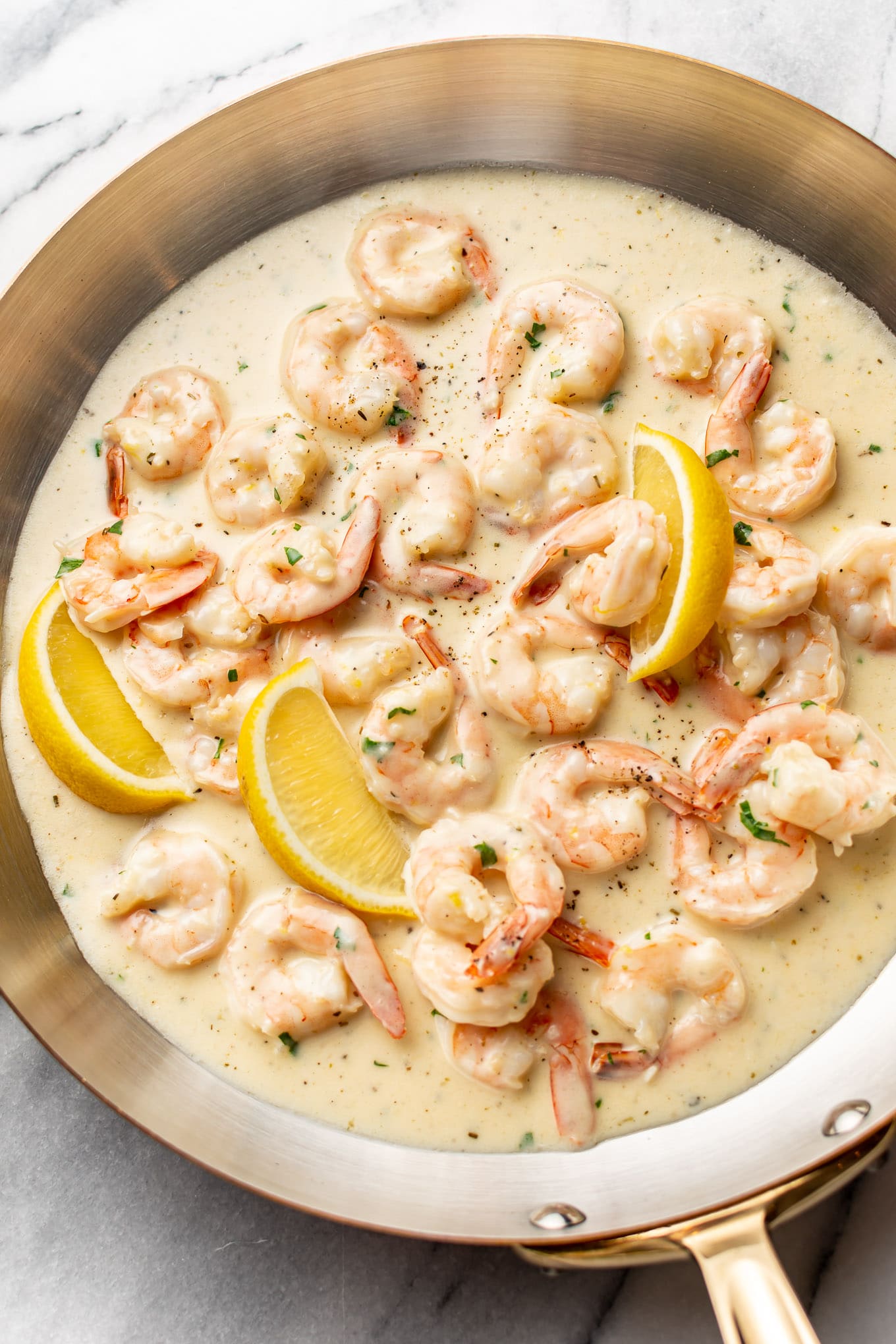
The cream sauce serves as both a cooking medium and a flavor delivery system, carrying and melding the various taste components while providing richness and body. The reduction process concentrates these flavors while creating the proper consistency for coating the shrimp. The sauce should taste rich and garlicky without being heavy or cloying, with a smooth, velvety texture that clings to the shrimp without being too thick.
Salt plays a crucial role in this dish, not just as a seasoning but as a flavor enhancer that brings out the natural tastes of all the other ingredients. The shrimp should be seasoned before cooking, but additional salt may be needed in the sauce, particularly after the cream is added. The salt should be added gradually and tasted frequently, as the sauce will concentrate as it reduces.
Acid provides balance to the rich cream sauce and helps brighten the overall flavor profile. Fresh lemon juice is traditional and provides a clean, bright acidity that complements seafood beautifully. The acid should be added near the end of cooking to preserve its fresh character, and the amount should be balanced so that it brightens the dish without making it taste sour.
Fresh herbs provide a bright, aromatic finish that elevates the dish from good to exceptional. Fresh parsley is classic and provides a clean, fresh flavor that cuts through the richness of the cream. Fresh chives, dill, or tarragon can provide different aromatic profiles, while fresh thyme or oregano can add more earthy, complex notes. The herbs should be added at the very end of cooking to preserve their bright color and fresh flavor.
Serving Suggestions and Presentation
The presentation and serving of Creamy Garlic Shrimp can significantly impact the overall dining experience, transforming a simple weeknight dinner into an elegant meal that feels special and memorable. Understanding how to plate the dish attractively and pair it with complementary sides can elevate the entire meal experience.
Traditional pasta pairings work beautifully with Creamy Garlic Shrimp, as the rich sauce naturally complements various pasta shapes and textures. Linguine or fettuccine are classic choices that allow the sauce to coat each strand beautifully, while the long, flat shape provides an elegant presentation. Angel hair pasta offers a more delicate option that won’t compete with the shrimp for attention, while penne or rigatoni provide pockets that capture and hold the creamy sauce.
Rice preparations offer another excellent foundation for this dish. Simple steamed white rice provides a neutral base that allows the flavors of the shrimp and sauce to shine, while absorbing the delicious cream sauce. Risotto creates a more luxurious presentation and complements the creamy texture of the sauce. Wild rice or rice pilaf can add textural interest and nutty flavors that pair well with the garlic and cream.
Vegetable accompaniments should be chosen to provide color, texture, and nutritional balance to the rich main dish. Steamed asparagus offers a bright green color and slightly bitter flavor that cuts through the richness of the cream sauce. Roasted Brussels sprouts, broccoli, or green beans provide similar benefits while adding different textures and flavors to the plate. Sautéed spinach or other leafy greens can be incorporated directly into the dish or served alongside.
Bread accompaniments are essential for sopping up every drop of the delicious cream sauce. Crusty French bread, garlic bread, or dinner rolls all work well. The bread should be warm and have enough structure to hold up to the sauce without becoming soggy. Garlic bread creates a particularly harmonious pairing, echoing the garlic flavors in the main dish.
The plating and presentation of Creamy Garlic Shrimp should emphasize the visual appeal of the dish while making it easy and enjoyable to eat. The shrimp should be arranged attractively over the chosen base, with the cream sauce spooned generously over and around them. A sprinkle of fresh herbs provides color contrast and aromatic appeal, while a light dusting of freshly grated Parmesan cheese can add both visual interest and additional flavor.
Nutritional Benefits and Dietary Considerations
Creamy Garlic Shrimp offers a complex nutritional profile that can be part of a balanced diet when prepared and consumed mindfully. Understanding the nutritional components and exploring possible adaptations can help you incorporate this beloved dish into various dietary approaches and health-conscious meal planning.
Shrimp provides exceptional nutritional value as a lean protein source that is naturally low in calories and saturated fat while being rich in important nutrients. A typical serving of shrimp provides high-quality protein that contains all essential amino acids necessary for muscle maintenance and growth. Shrimp is also an excellent source of selenium, a powerful antioxidant that supports immune function and thyroid health, as well as vitamin B12, which is essential for nervous system function and red blood cell formation.
The iodine content in shrimp makes it particularly valuable for thyroid health, while the omega-3 fatty acids, though present in smaller amounts than in fatty fish, still contribute to cardiovascular health and brain function. Shrimp is also a good source of phosphorus, which is important for bone health, and zinc, which supports immune function and wound healing.
The cream sauce, while indulgent, does provide some nutritional benefits along with its rich flavor and satisfying texture. Heavy cream contains fat-soluble vitamins A, D, E, and K, as well as calcium and phosphorus. However, it is also high in saturated fat and calories, which should be considered when planning the overall meal and daily nutrition intake.
For those looking to reduce the caloric content of the dish, several modifications can be made without significantly compromising flavor. Half-and-half can be substituted for heavy cream, though the sauce will be slightly less rich and may require more careful temperature control. Greek yogurt can be stirred in at the end of cooking to add creaminess and protein while reducing overall fat content, though this will change the flavor profile somewhat.
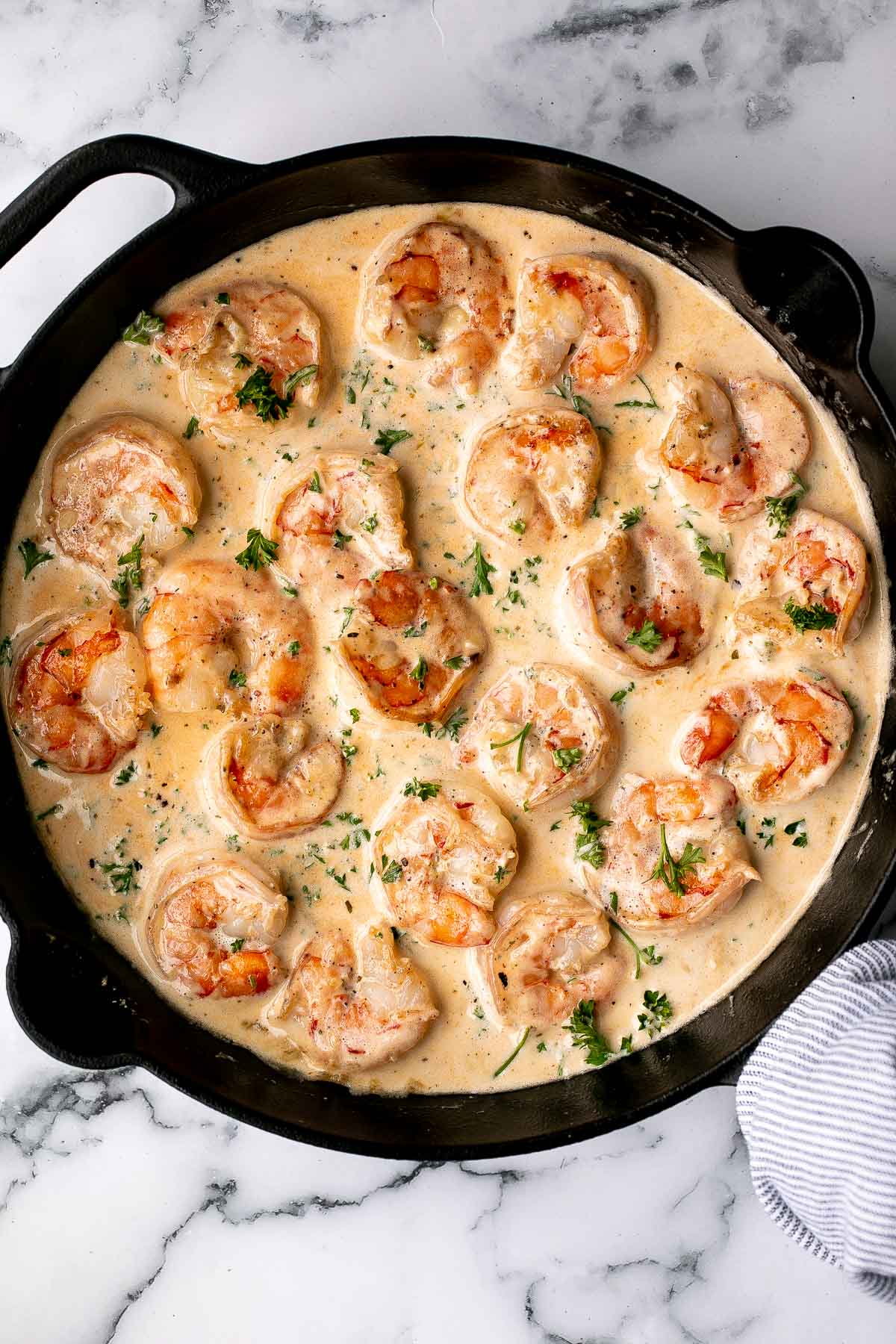
Coconut cream can provide a dairy-free alternative that maintains richness while adding subtle tropical notes that complement seafood well. This substitution makes the dish suitable for those following dairy-free or paleo diets. Cashew cream, made by blending soaked cashews with water, offers another dairy-free option with a neutral flavor that won’t compete with the other ingredients.
For those following low-carb or ketogenic diets, Creamy Garlic Shrimp is naturally well-suited, as it is high in fat and protein while being very low in carbohydrates. When served over zucchini noodles, cauliflower rice, or simply with vegetables, it becomes a perfect keto-friendly meal that doesn’t sacrifice flavor or satisfaction.
The sodium content of the dish can be controlled by using fresh shrimp rather than processed or pre-seasoned varieties, and by being mindful of salt additions during cooking. Those watching sodium intake can reduce the salt in the recipe and rely more heavily on herbs, spices, and acid for flavor enhancement.
Storage, Reheating, and Meal Prep Strategies
Understanding proper storage and reheating techniques for Creamy Garlic Shrimp ensures that you can enjoy this dish safely and deliciously as leftovers, while also exploring possibilities for meal prep strategies that can save time during busy weeks without compromising quality or food safety.
Proper storage begins with cooling the dish quickly and safely. Cooked shrimp should not be left at room temperature for more than two hours, and in hot weather (above 90°F), this time is reduced to one hour. The dish should be transferred to shallow containers to promote rapid cooling, and then refrigerated promptly. When stored properly in the refrigerator, Creamy Garlic Shrimp will maintain its quality for 2-3 days, though it’s best consumed within 24 hours for optimal texture and flavor.
The cream sauce may separate slightly during storage, which is normal and can be corrected during reheating. However, it’s important to note that cream sauces generally don’t freeze well, as the emulsion breaks down during the freezing and thawing process, resulting in a grainy, separated texture that cannot be fully restored.
Reheating requires gentle techniques to prevent the cream sauce from breaking and the shrimp from becoming tough and overcooked. The stovetop method works best: place the leftovers in a skillet over low heat, adding a splash of cream, milk, or chicken broth if the sauce appears too thick. Heat slowly, stirring gently, until warmed through. The goal is to heat the dish just enough to make it palatable without cooking the shrimp further.
The microwave can be used for reheating but requires careful attention to prevent overcooking. Use 50% power and heat in short intervals of 30-45 seconds, stirring between each interval. Add a small amount of liquid if the sauce appears too thick, and stop heating as soon as the dish is warmed through.
For meal prep purposes, this dish is best prepared fresh rather than made ahead, as both the shrimp and cream sauce are at their best when freshly prepared. However, some components can be prepped in advance to streamline the cooking process. The shrimp can be cleaned, peeled, and seasoned ahead of time, then stored in the refrigerator until ready to cook. The garlic can be minced and stored in a small amount of oil to prevent oxidation.
If you must prepare the dish in advance, consider preparing the components separately and combining them just before serving. Cook the shrimp and set aside, then prepare the cream sauce separately. When ready to serve, gently reheat the sauce and add the cooked shrimp just long enough to warm them through.
Troubleshooting Common Issues and Professional Tips
Even experienced cooks can encounter challenges when preparing Creamy Garlic Shrimp, and understanding how to identify and correct common problems can mean the difference between a successful dish and a disappointing meal. Learning from professional techniques can also help elevate your home cooking to restaurant quality.
One of the most common issues is overcooked shrimp, which become tough, rubbery, and unpleasant to eat. This typically occurs when the shrimp are cooked too long or at too high a temperature. Prevention is the best approach – use medium-high heat and watch the shrimp carefully, removing them from heat as soon as they turn pink and opaque. If shrimp do become overcooked, there’s unfortunately no way to reverse the damage, so it’s better to err on the side of slight undercooking, as the shrimp will continue to cook slightly from residual heat.
A broken or curdled cream sauce is another frequent problem that can ruin an otherwise perfect dish. This typically occurs when the cream is heated too quickly or to too high a temperature, causing the proteins to coagulate and separate from the fat. Prevention involves using low to medium-low heat when working with cream and adding it gradually while stirring constantly. If the sauce does break, it can sometimes be rescued by removing it from heat and whisking in a tablespoon of cold cream or a small amount of cold butter.
Burnt garlic can introduce bitter flavors that are difficult to mask and can overpower the delicate flavor of the shrimp. Garlic burns quickly over high heat, so it should be cooked over medium heat and stirred constantly. If garlic does burn, it’s often better to start over rather than try to salvage the dish, as the bitter flavors will permeate the entire sauce.
Under-seasoned sauce can be disappointing after all the effort put into preparation. This often occurs when cooks are hesitant to season adequately or when they fail to taste and adjust throughout the cooking process. Remember that cream can mute other flavors, so the sauce may need more salt, garlic, or acid than you initially expect. Always taste and adjust seasoning at the end of cooking.
Professional chefs often use a technique called “mounting” to finish cream sauces, which involves whisking in cold butter at the end of cooking. This technique adds richness and gloss to the sauce while helping to stabilize the emulsion. The butter should be cold and added gradually while whisking constantly, off the heat to prevent the sauce from breaking.
Temperature control is crucial for achieving restaurant-quality results. Professional kitchens use precise temperature control that home stoves may not match, but you can compensate by using lower heat settings and being patient with the cooking process. It’s better to cook slowly and achieve perfect results than to rush and risk overcooking or breaking the sauce.
Variations and Creative Adaptations
The basic framework of Creamy Garlic Shrimp provides an excellent foundation for numerous variations and creative adaptations that can keep this dish fresh and exciting while accommodating different tastes, dietary needs, and seasonal ingredient availability.
Herb variations can dramatically change the character of the dish while maintaining its essential appeal. Fresh basil creates an Italian-inspired version that pairs beautifully with tomatoes and pasta. Fresh dill provides a Scandinavian twist that complements the seafood beautifully. Tarragon adds a sophisticated, slightly licorice-like flavor that works particularly well with cream sauces. Fresh cilantro can create a more contemporary, globally-inspired version.
Spice additions can add complexity and heat to the dish without overwhelming the delicate flavor of the shrimp. A pinch of red pepper flakes provides gentle heat, while paprika adds color and subtle smokiness. Cajun seasoning can transform the dish into a New Orleans-inspired creation, while curry powder creates an interesting fusion approach.
Vegetable additions can increase the nutritional value and visual appeal of the dish while adding textural interest. Cherry tomatoes provide bursts of acidity and color that complement the rich cream sauce. Mushrooms add earthy depth and meaty texture. Asparagus or snap peas contribute color and crunch. Sun-dried tomatoes provide concentrated flavor and beautiful color contrast.
Wine additions can add depth and complexity to the sauce. White wine is traditional and provides acidity that balances the richness of the cream. Dry sherry adds nutty, complex flavors, while a splash of brandy or cognac creates a more luxurious version. The alcohol should be added before the cream and allowed to cook off partially before proceeding with the sauce.
Different protein combinations can create interesting variations while maintaining the essential character of the dish. Scallops can be substituted for or combined with shrimp for a more luxurious seafood medley. Chicken can be used for those who prefer poultry, though cooking times will need to be adjusted. A combination of shrimp and crabmeat creates an indulgent surf-and-surf variation.

Creamy Garlic Shrimp
Ingredients
Method
- Pat the shrimp dry and season with salt and pepper.
- In a large skillet, heat olive oil and 1 tbsp of butter over medium-high heat. Add the shrimp in a single layer and cook for 1-2 minutes per side, until pink and just cooked through. Remove shrimp from the skillet and set aside.
- In the same skillet, melt the remaining 1 tbsp of butter over medium heat. Add the minced garlic and red pepper flakes (if using) and cook for about 30 seconds until fragrant, being careful not to burn the garlic.
- Pour in the chicken broth or white wine to deglaze the pan, scraping up any browned bits from the bottom of the skillet. Bring to a simmer and cook for 2-3 minutes, until the liquid has reduced by about half.
- Reduce the heat to low and stir in the heavy cream. Bring to a gentle simmer and cook for 2-3 minutes, until the sauce has thickened slightly.
- Stir in the grated Parmesan cheese until melted and the sauce is smooth. Remove from heat and stir in the fresh lemon juice and chopped parsley.
- Return the cooked shrimp to the skillet and toss to coat with the creamy garlic sauce.
- Serve immediately over pasta, rice, or with crusty bread to soak up the delicious sauce.
Notes
Conclusion
Creamy Garlic Shrimp represents the perfect embodiment of comfort food that manages to feel both indulgent and sophisticated, combining simple ingredients and straightforward techniques to create a dish that satisfies on multiple levels. The tender, sweet shrimp paired with the luxurious, aromatic cream sauce creates a meal that feels both familiar and special, making it suitable for countless occasions from intimate family dinners to elegant entertaining.
The versatility of this dish makes it a valuable addition to any cook’s repertoire, as it can be adapted to accommodate different dietary needs, seasonal ingredients, and personal preferences while maintaining its essential character and appeal. Its relatively quick cooking time makes it perfect for weeknight dinners, while its elegant presentation makes it suitable for special occasions and dinner parties.
Mastering this recipe provides more than just another dish for your collection – it teaches fundamental cooking techniques that can be applied to countless other preparations. The skills involved in properly cooking seafood, creating stable cream sauces, and balancing flavors are foundational techniques that will serve you well throughout your culinary journey.
Perhaps most importantly, Creamy Garlic Shrimp embodies the joy of cooking and sharing good food with the people we care about. The aromatic garlic and rich cream sauce create an atmosphere of warmth and comfort that transforms an ordinary meal into a special occasion. Whether you’re cooking for your family on a busy weeknight or preparing a romantic dinner for two, this dish has the power to create lasting memories and bring people together around the table.
As you embark on your own journey with this recipe, remember that cooking is both an art and a science. While following the techniques and guidelines outlined in this guide will help ensure success, don’t be afraid to make the dish your own through small adjustments and personal touches. The best recipes are those that evolve and adapt to reflect the tastes and preferences of the cook and their loved ones, creating new traditions and memories with each preparation.
